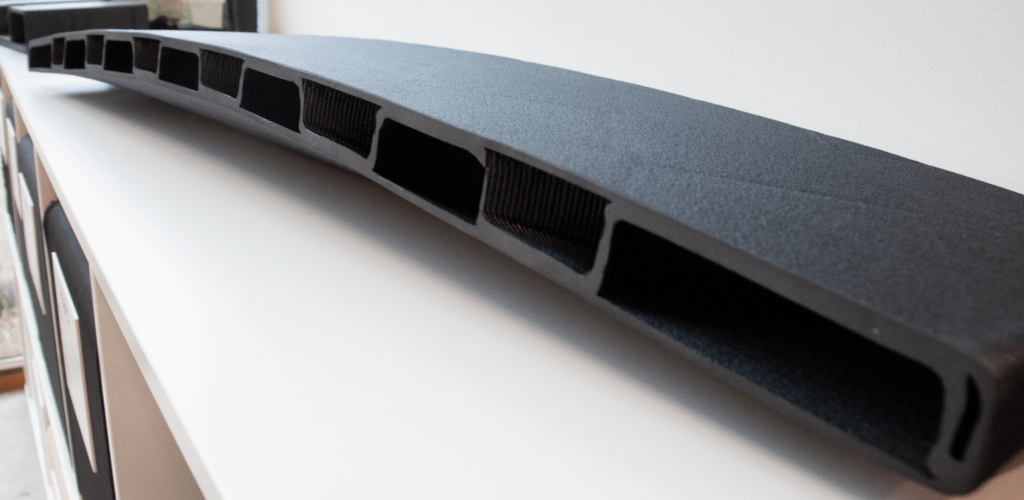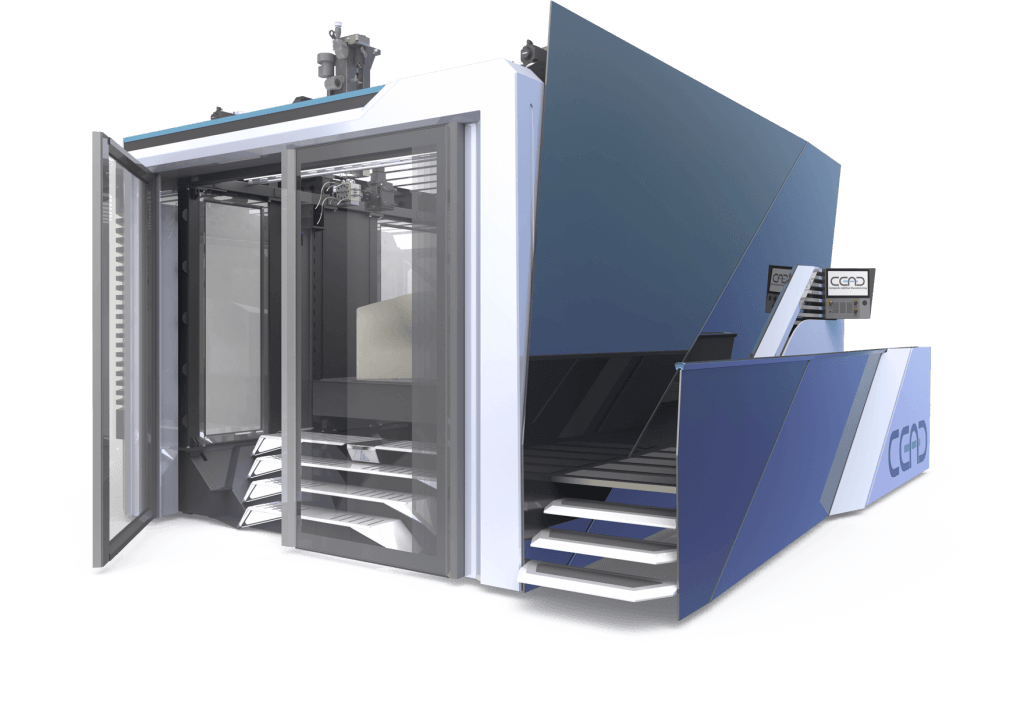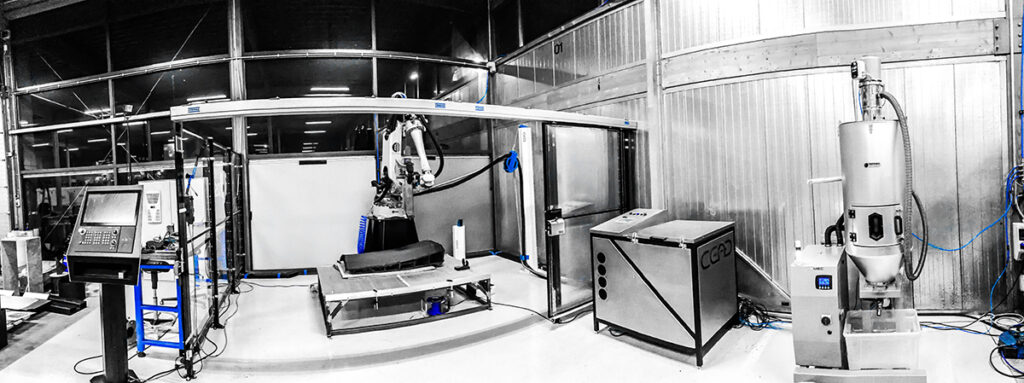Biopolymers Used to 3D Print Large-scale Marine Fender
As discussed in our series on the role of 3D printing and polymers in (averting or contributing to) ecological collapse, biopolymers may be a crucial factor in the equation to maintain some semblance of post-industrial society that can coexist with life on Earth. Now, the SeaBioComp project has demonstrated the possibilities of 3D printing biopolymers for large-scale industrial use.
The many members of the EU-funded Interreg initiative opted to produce a fender used to protect structures when berthing and guiding ships. In order to replace tropical wood and synthetic plastics in fender construction, the team explored the use of two materials, recycled PETG with glass fiber reinforcement (rPETG-GF30) and thermoplastic starch polymer (TSP).
Project member De Klerk Waterbouw, a specialist in the installation of marine products, outlined the design requirements for the component. This included a width of 400 mm, a base that allows it to slide into an auxiliary structure, an open cavity that can be filled with materials to improve impact resistance and energy absorption.
A sample fender unit made from a combination of TPS and PLA was printed by Dutch composite production company Poly Products using a large-scale 3D printer from CEAD. The structure underwent material testing by the University of Portsmouth and mechanical testing by De Klerk Waterbouw, which reported promising results. The next step is for a further optimization of the design, materials and production process before a full-scale fender is made.

The 3D-printed fender prototype made with a TSP-PLA blended bioplastic. Image courtesy of SeaBioComp.
The findings from the material testing led by the University of Portsmouth and mechanical testing by De Klerk Waterbouw show very promising results and further optimization of designs, materials and production may lead to future full-scale production. This will lead to the installation of a full-scale, 3D-printed fender to test the performance of the structure in the field.
As discussed in our story on TSPs, these materials are difficult to process and brittle at room temperature. Made from starches themselves (as opposed to the lactic acid derived from starches, like PLA), TSPs are usually blended with other plasticizers. In this case, the TSP was mixed with PLA, which has is its own ecological issues but demonstrates strong promise over petrochemical polymers if it can be grown and harvested sustainably.
Because chemical companies are investing in fossil fuel-based plastics (in addition to biopolymers) in part to hedge their bets on a global transition to renewable energy (which also has its own ecological issues), there is a need to demonstrate the viability of biopolymers in large-scale industrial applications. For this reason, researchers from the Singapore University of Technology and Design 3D printed a fully biodegradable wind turbine blade out of chitin and cellulose.
If we can show the world that biopolymers like TSPs can be used to replace traditional petro-plastics, there is the possibility that we can maintain some of the trappings of post-industrial society while relying on more sustainable resources. We are, however, a long way from exhibiting those possibilities. The SeaBioComp project is a small, but important step in showing the applications of 3D printing with bioplastics.
In addition to demonstrating such applications, it will be important to report the lifecycle of these projects, including where and how the materials were gathered, the total lifespan of the items made, and where they end up, as well as shipping emissions and energy used to produce them. The degrowth movement has also shown us that it’s also necessary not just to replace existing materials and production technologies, but to shrink total production and consumption, as Jevon’s paradox can lead so-called sustainable processes to increase total production and consumption activities, simply adding to the total material and emissions footprints of existing fossil fuel-based operations.
Organizations wishing to be informed about the SeaBioComp project can sign up for updates here and reports about the project can be found here.
The post Biopolymers Used to 3D Print Large-scale Marine Fender appeared first on 3DPrint.com | The Voice of 3D Printing / Additive Manufacturing.
Siemens and CEAD Develop Hybrid 3D Printing Robotic Arm
3D printing with continuous reinforcement fibers, like carbon fiber, is just now starting to come into its own, with numerous startups developing their own unique approaches to the concept. Their presence on the market is a different story, as many of these firms are still in the R&D or beta stages. Dutch firm CEAD, however, is already in the process of building and shipping its massive reinforcement fiber 3D printers and has already developed, in partnership with Siemens, a follow-up system that it will be showcasing at Formnext 2019: the AM Flexbot.
You may have caught our previous coverage of CEAD and its Continuous Fiber Additive Manufacturing (CFAM) process. The company’s first printer, the CFAM Prime, has a massive build envelope of 4mx2mx1.5m and is, according to CEAD, able to print thermoplastics reinforced with continuous glass or carbon fiber at a rapid average rate of 15 kg/hr. To maintain precision while depositing at such speeds, the system is controlled by Siemens’ Sinumerik 840D sl.
The firm’s new technology, the AM Flexbot, extends CEAD’s partnership with Siemens, resulting in a 3D printing process that uses a large-scale industrial robotic arm as a motion platform. The system features CEAD’s single screw extruder unit mounted onto a Comau robotic arm, all controlled by Siemens’ Sinumerik CNC with Run MyRobot /Direct Control software. For clarification: the AM Flexbot does not perform continuous fiber reinforcement.

CEAD parts for a small pedestrian bridge the company is making.
CEAD turned to Comau and Sinumerik Run MyRobot/Direct Control in order to maintain the precision necessary to accurately deposit the material to near-net-shape before milling parts to completion. The AM Flexbot is now available for purchase, but CEAD is aiming to expand its feature set. If the system can both 3D print and mill, it’s possible to imagine what additional capabilities it might have. This could include performing quality control metrology once a print has been completed, using robotic grippers to add external components, or working in tandem with other robotic arms to create even larger structures.
CEAD co-founder and Operations Director Lucas Janssen said of the product, “By using Siemens’ Sinumerik Run MyRobot /Direct Control together with a Comau robot arm in our latest solution, we are able to deliver a modular system scalable to fit our customer’s needs as many different functions can be added at any time. We are very pleased to work with Siemens and their reliable products.”
CEAD is not alone in the fiber reinforcement or robotic arm space. In terms of the former, companies like AREVO, Impossible Objects, Markforged, Desktop Metal, Anisoprint, and Continuous Composites are just a few who are either working on fiber reinforcement 3D printing or have commercial products readily available. For robotic arms, 3D Systems, MX3D, Stratasys, and EnvisionTEC are only the commercial companies who are either working on 3D printing with robotic arms or have solutions commercially available. In both spaces, there are countless research projects being performed, so CEAD will find itself with plenty of company in the near future.
The AM Flexbot will be on display at the Siemens booth (D81, Hall 12.1) at Formnext 2019, but if you don’t catch it there, Siemens will also be including a CEAD 3D printing system at its Additive Manufacturing Experience Center (AMEC) in Erlangen, Germany.
The post Siemens and CEAD Develop Hybrid 3D Printing Robotic Arm appeared first on 3DPrint.com | The Voice of 3D Printing / Additive Manufacturing.



